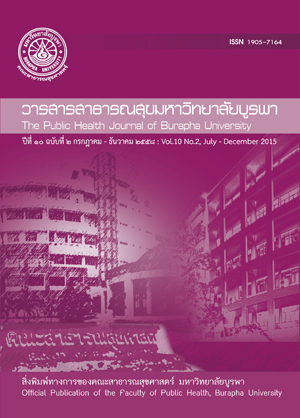ผลของโปรแกรมอาชีวสุขศึกษาต่อการลดการสัมผัสสารตะกั่วของช่างหมันในอู่ต่อเรือ จังหวัดนครศรีธรรมราช
Main Article Content
บทคัดย่อ
สารตะกั่วออกไซด์ (Pb3O4) ถูกนำมาใช้ในขั้นตอนตอกหมันเพื่อต่อและซ่อมเรือไม้ การศึกษาครั้งนี้เพื่อเปรียบเทียบระดับความรู้ พฤติกรรมการป้องกันการสัมผัสสารตะกั่ว ขนาดการสัมผัสสารตะกั่วที่ตัวบุคคลและการปนเปื้อนบริเวณที่พักอาศัยของช่างหมัน ก่อนและหลังการให้กิจกรรมอาชีวสุขศึกษาเพื่อลดการสัมผัสสารตะกั่วจากการทำงาน มีกลุ่มตัวอย่างเข้าร่วมศึกษา จำนวน 45 คน รวบรวมข้อมูล ได้แก่ ประวัติการทำงาน แหล่งปนเปื้อน ความรู้และพฤติกรรมการป้องกันการสัมผัสสารตะกั่ว โดยใช้แบบสัมภาษณ์ พร้อมเก็บตัวอย่างเลือด จำนวน 37 คน และตัวอย่างฝุ่นบริเวณขอบหน้าต่างและพื้นบ้าน จำนวน 28 ครัวเรือน เพื่อนำไปวิเคราะห์ปริมาณสารตะกั่วก่อนและหลังดำเนินกิจกรรม
ผลการศึกษาพบว่าหลังจากจัดกิจกรรมอาชีวสุขศึกษา ประมาณ 8 เดือน กลุ่มตัวอย่างมีระดับความรู้เกี่ยวกับการป้องกันและผลกระทบจากสารตะกั่วเฉลี่ยเพิ่มขึ้นจาก 70.9 เป็น 74.4 เปอร์เซ็นต์ (p<0.05) ได้ปรับเปลี่ยนพฤติกรรมในการทำงานและป้องกันการปนเปื้อนสารตะกั่วบริเวณที่พักอาศัย ได้แก่ ล้างมือก่อนดื่มน้ำและรับประทานอาหารว่างในระหว่างการทำงาน เปลี่ยนชุดทำงานก่อนกลับบ้านหรือเข้าบ้านพัก ระดับสารตะกั่วในเลือดมีค่าเฉลี่ยลดลงจาก 48.4 เป็น 26.0 μg/dl ปริมาณสารตะกั่วบริเวณพื้นบ้านมีค่ามัธยฐานลดลงทุกตำแหน่งอย่างมีนัยสำคัญทางสถิติ (p<0.01) หากเปรียบเทียบกับมาตรฐานขององค์กรพิทักษ์สิ่งแวดล้อมและกระทรวงการเคหะและพัฒนาเขตเมืองของสหรัฐอเมริกาซึ่งกำหนดปริมาณตะกั่วบริเวณพื้นบ้าน ไม่ควรเกิน 430.4 μg/m2 พบว่ามีจำนวนบ้านตัวอย่างเกินค่ามาตรฐานดังกล่าวอย่างน้อยหนึ่งตำแหน่ง ลดลงจาก 78.6 เป็น 53.6 เปอร์เซ็นต์ ผลการศึกษาชี้ให้เห็นว่าการจัดกิจกรรมอาชีวสุขศึกษา ส่งผลให้ช่างหมันปรับเปลี่ยนพฤติกรรมเพื่อลดการสัมผัสสารตะกั่วขณะทำงานและบริเวณที่พักอาศัยของตนเองได้
The Results of Occupational Health Education Program for Reducing Lead Exposure among Boat-caulkers, Nakhon Si Thammarat Province
Lead oxide (Pb3O4 ) is used extensively in the process of caulking, in the construction and repair of wooden boat in Thailand. This study compared knowledge score about lead, blood lead and surface lead after provided occupational health education to reducing lead exposure. Forty-five caulkers participated in this study. Thirty-seven blood lead samples were assessed. Surface-wipe lead loading was measured at windowsill and room floors in the homes of 28 caulkers. A questionnaire was administered to collect information on work history, lead sources, personal behavior and knowledge about lead.
After the occupational health education as training program about 8 months, the average of knowledge score about lead improved from 70.9 to 74.4 percent (p<0.05). They improved personal hygiene, such as washing hand before drinking and eating snacks, and changing work-clothes before going home or entering their home. The mean of blood lead decreased from 48.4 to 26.0 μg/dl. Median lead loading of all floor locations decreased in highly significant (p<0.01) and number of workers’ homes exceeded the US Environmental Protection Agency (EPA) and Department of Housing and Urban Development (HUD) hazard standards which defined dangerous level lead in settled dust of 430.4 μg/m2 for floors decreased (from 78.6 to 53.6 percent). These results indicated occupational health education program can improve lead-safe practices and reduce the risk of lead poisoning of caulkers and magnitude of take-home lead.
Article Details
เอกสารอ้างอิง
2. Bonde JP, Joffe M, Apostoli P, Dale P, Kiss P, Spano M, et al. Sperm count and chromatin structure in men exposed to inorganic lead: lowest adverse effect levels. Occup Environ Med 2002; 59: 234-42.
3. Nomiyama K, Nomiyama H, Liu S.L, Tao YX, Nomiyama T, Omae K. Lead induced increase of blood pressure in female lead workers. Occup Environ Med 2002; 59: 734-9.
4. Weaver VM, Lee BK, Ahn KD, Lee GS, Todd AC, Stewart WF, et al. Associations of lead biomarkers with renal function in Korean lead workers. Occup Environ Med 2003; 60: 55-62.
5. Telisman S, Pizent A, Jurasovic J, Cvitkovic P. Lead effect on blood pressure in moderately lead-exposed male workers. Am J Ind Med 2004; 45: 446-54.
6. Thanapop C, Geater A. Indentification of jobs and behaviors of boat-repair workers associated with personal and take-home lead contamination. Final report. Institute of Research and Development for Health of Southern (RDH); 2007 Feb. Report No.: RDG 4880001.
7. Thanapop C, Geater AF, Robson MG, Paktongsuk P. Elevated lead contamination in boat-caulkers’ homes in southern Thailand. Int J Occup Environ Health 2009; 15: 282-90.
8. Untimanon O, Geater AF, Chongsuvivatwong V, Saetia W, Utapan S. Skin lead contamination of family members of boat-caulkers in southern Thailand. Industrial Health 2011; 49: 37-46.
9. Askin DP, Volkmann M. Effect of personal hygiene on blood lead levels of workers at a lead processing facility. Am Ind Hyg Assoc J 1997; 58: 752-3.
10. Lormphongs S, Morioka I, Miyai N, Yamamoto H, Chaikittiporn C, Thiramanus T, Miyashita K. Occupational health education and collaboration for reducing the risk of lead poisoning of workers in a battery manufacturing plant in Thailand. Industrial Health; 2004, 42: 440-5.
11. Eller PM, Ashley K. Analytical method number 9100: Lead in surface wipe method. In National Institute for Occupational Safety and Health (NIOSH). NIOSH Manual of analytical methods (NMAM). 4th ed. Cincinnati, Ohio; 1996.
12. Millson M, Hull RD. Analytical method number 7082: Lead by flame AAS. In National Institute for Occupational Safety and Health (NIOSH). NIOSH Manual of analytical methods (NMAM). 4th ed. Cincinnati, Ohio; 1994.
13. Perkins JM, Stephens BE, Beesley MP. Analytical method number 7105: Lead by GFAAS. In National Institute for Occupational Safety and Health (NIOSH). NIOSH Manual of analytical methods (NMAM). 4th ed. Cincinnati, Ohio; 1994.
14. Janz NK, Becker MH. The Health Belief Model: A Decade Later. Health Education Quarterly [Internet].1984 [cite 2012 Jun 20]; 11: 1-47. Available from: http://deepblue.lib.umich.edu/bitstream/handle/2027.42/66877/10.1177_1090198184011001? sequence=2
15. Lauritsen JM, Bruus M. EpiData (3.1): A comprehensive tool for validated entry and documentation of data. The EpiData Association, Odense, Denmark; 2005.
16. Hornung RW, Reed LD. Estimation of average concentration in the presence of nondetectable values. Appl Occup Environ Hyg 1990; 5: 46-51.
17. U.S. Department of Housing and Urban Development (HUD). Guidelines for the Evaluation and Control of Lead-Based Paint Hazards in Housing. Washington; 1995.
18. U.S. Environmental Protection Agency (EPA). 40 CFR PART 745 Lead; Identification of dangerous levels of lead. final rule. 2001.
19. U.S. Department of Housing and Urban Development (HUD). HUD Lead Safe Housing Rule, 24 CFR 35, subparts B through R, reflecting changes made by the technical amendment issued June 21, 2004 (69 Federal Register 34262-34276). [Internet]. 2004 [cite 2009 Sept 1]. Available from: http://www.hud.gov/offices/lead/leadsaferule/LSHRFinal21June04.rtf
20. Thanapop C, Geater AF, Robson MG, Paktongsuk P, Viroonudomphol D. Exposure to lead of boatyard workers in southern Thailand. J Occup Health 2007; 49: 345-352.
21. Stuart BO. Deposition and clearance of inhaled particles. Environ Health Perspect 1976; 16: 41-53.
22. Chuang HY, Lee MT, Chao KY, Wang JD, Hu H. Relationship of blood lead levels to personal hygiene habits in lead battery workers: Taiwan, 1991-1997. Am J Ind Med 1999; 35: 595-603.
23. Porru S, Donato F, Apostoli P, Coniglio L, Duca P, Alessio L. The utility of health education among lead workers: the experience of one program. Am J Ind Med 1993; 22: 473-81.
24. Materna Bl, Harrington D, Scholz P, Payne SF, Stubbs HA, Hipkins K, et al. (2002). Results of an intervention to improve lead safety among painting contractors and their employees. Am J Ind Med 2002; 41: 119-30.

